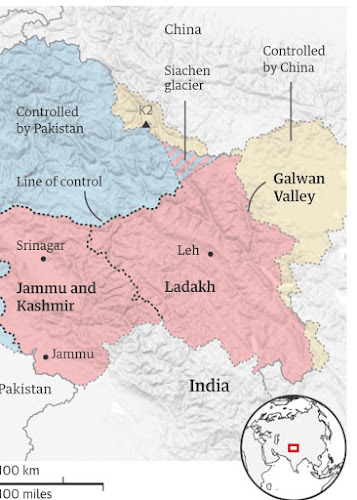There are always some kind of conflicts between India and China. Both the countries are powerful in each and every category: economically strong; strong defence system; good resources; developed technology and many more.
What is the issue?
The issue is based on the border territories between the two countries.
LAC (Line of Actual Control) is the fulcrum, where a region of 10 km is under dispute.
LAC is a line of border separation between India and China in the Ladakh but the LAC is not demarcated, therefore both the countries define LAC differently which led to confronts.
So there is a common area of dispute which is called as Area of Differing Perception.
Image credit: Guardian.com
LINE OF ACTUAL CONTROL (LAC)
The LAC is a rough demarcation line separating Indian-controlled territory from Chinese-controlled territory. The exact location of sections of the line, particularly in the western Ladakh region, have remained in dispute. Efforts between the two countries to clarify the LAC have stalled in the past two decades.
Overview
The army of both the countries used to patrol in the LAC and sometimes there were clashes between them, sometimes you might have heard of these in news also.
Also there were not any posts of the army in the LAC area.
The first official acknowledgment of tensions on the border came on May 10, when the Army issued a statement about clashes between Indian and Chinese patrols at two places.
Chinese army augmented the military equipment and number of soldiers around the border near LAC in Ladakh.
The most serious issue is in the area of Pangong Tso lake and its northern banks, where Chinese soldiers have moved up to the line they perceive to be the LAC.
Also the Chinese started construction work there and the Indians objected.
In the area of Hot Spring, Chinese soldiers have moved into three areas of PP14, PP15, and Gogra, backed by a large number of troops and heavy equipment on their side.
There are similar reports of a massive Chinese deployment on their side in the Galwan river valley area.
The conflict broke out in Galwan Valley on June 15. It is said that the Indian army had burnt some items like tents of Chinese in which they had to reside .
The refusal of Chinese army to leave disputed areas, including the Galwan Valley inside Indian territory, has triggered shouting matches, stone-throwing and fistfights in key border areas. Last month, there was a massive brawl between patrols, but no deaths.
What countries want?
Both countries have sought to establish their claims to territory, by heavily militarising the region.
Both have built roads, airstrips, outpost stations, and other infrastructure, such as telephone lines. Troops conduct regular patrols along the disputed border.
Negotiations and Way Ahead
There have been multiple rounds of talks at the level of local military commanders (Colonel- and Brigadier-level), and three rounds of talks at the level of the division commanders (Major General).
After these talks were inconclusive, Corps Commander-level talks were held on. Simultaneous talks have taken place at the diplomatic level in Beijing and New Delhi.
Now Russia will help both the countries to resolve the issue at diplomatic level.
The Foreign Ministers of both the countries will discuss the issue and with Russian diplomat as mediator.
NEXT BLOG: WHAT OTHERS HAVE TO SAY ABOUT CHINA'S SORDID ACT.
READ HERE: http://ieasyarticles.blogspot.com/2020/06/what-others-have-to-say-about-chinas.html

Comments
Post a Comment